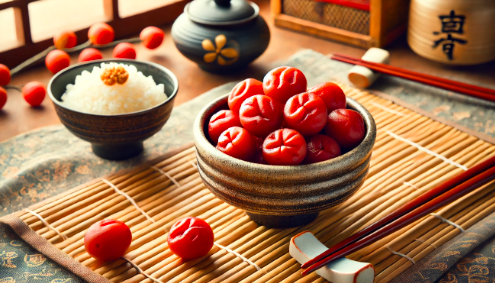
What Are Red Salted Plums?
Red salted plums are a delightful preserved fruit cherished across various cultures for their unique flavor profile, which combines salty, tangy, and occasionally sweet notes. These plums undergo a meticulous preservation process, often involving salting, fermentation, and sometimes the addition of red shiso leaves for a striking color and enhanced flavor.
Historical Significance and Cultural Importance
Red salted plums have a rich history that spans centuries. In Japan, they are known as “umeboshi,” a staple in traditional diets and a symbol of health and longevity. In Chinese and Hawaiian cultures, variations like “li hing mui” are popular snacks, while in Mexico, “saladitos” are enjoyed for their tangy and salty kick. Each culture brings its own unique twist to this preserved delicacy.
Varieties of Red Salted Plums
Umeboshi: The Japanese Pickled Plum
Umeboshi, often called the quintessential red salted plum, is made from ume fruits, which are closer to apricots than plums. The fruits are salted, fermented, and sun-dried, often with red shiso leaves to impart their signature crimson hue. Umeboshi is traditionally eaten with rice or used as a filling for onigiri (rice balls).
Li Hing Mui: A Hawaiian Favorite
Li hing mui originates from Chinese culinary traditions and is a hit in Hawaii. These plums are preserved with salt, sugar, and licorice powder, creating a sweet, salty, and tangy snack. Li hing mui powder is also used to flavor candies, drinks, and even fruits like pineapple.
Saladitos: A Mexican Delight
Saladitos are dried, salted plums enjoyed as a standalone snack or paired with fresh fruits. They’re known for their intense saltiness and tanginess, making them a favorite for enhancing the flavor of beverages like beer or fruit juices.
Health Benefits and Nutritional Profile
Red salted plums offer more than just a tantalizing taste; they come packed with nutrients and potential health benefits:
- Rich in Antioxidants: Umeboshi, for instance, contains polyphenols that combat oxidative stress.
- Digestive Aid: The sourness of these plums stimulates saliva production, aiding digestion.
- Source of Essential Minerals: They provide potassium, calcium, and magnesium.
Nutritional Breakdown (Per 100g)
| Nutrient | Amount |
| Calories | 33 |
| Protein | 0.9g |
| Carbohydrates | 8.8g |
| Sodium | 800mg |
| Vitamin C | 6mg |
How to Prepare Red Salted Plums
Making red salted plums at home is a rewarding process. Here’s a simplified guide:
- Select Fresh Fruits: Choose firm, ripe plums or ume fruits.
- Salting: Coat the fruits with sea salt and place them in a jar with a weighted lid.
- Fermentation: Allow the plums to ferment for about two weeks.
- Drying: Remove the plums and sun-dry them for several days.
- Adding Red Shiso: Toss the dried plums with red shiso leaves for color and flavor.
Culinary Uses and Recipes
Traditional Dishes
Red salted plums are incredibly versatile. Umeboshi pairs perfectly with plain rice, offering a burst of flavor. Li hing mui powder is often sprinkled over tropical fruits like mango or pineapple.
Modern Innovations
Chefs worldwide are reimagining red salted plums:
- Umeboshi-infused pasta sauce.
- Li hing mui cocktails.
- Saladitos as a seasoning for roasted vegetables.
Recipe: Umeboshi Rice Balls
- Prepare steamed rice and let it cool slightly.
- Take a small portion of rice and flatten it in your palm.
- Place a piece of umeboshi in the center.
- Wrap the rice around the plum, shaping it into a ball.
- Optionally, wrap with seaweed.
Where to Buy and Store Red Salted Plums
Buying Guide
You can find red salted plums in:
- Specialty Asian Stores: These often carry authentic umeboshi.
- Online Retailers: Platforms like Amazon offer a variety of options.
- Local Markets: Check for li hing mui or saladitos in ethnic sections.
Storage Tips
Store your red salted plums in a cool, dry place. Refrigeration extends their shelf life, especially if they’re homemade. Ensure the container is airtight to maintain freshness.
FAQs About Red Salted Plums
1. Are red salted plums vegan?
Yes, they are typically vegan, as they’re made from fruits, salt, and natural flavorings.
2. Can red salted plums be used in desserts?
Absolutely! Umeboshi pairs well with creamy desserts, while li hing mui powder is a great addition to sorbets and candies.
3. Do red salted plums have medicinal uses?
In traditional medicine, they are used to aid digestion and combat fatigue.
4. What makes umeboshi red?
The red color comes from red shiso leaves, a natural dye and flavor enhancer.
5. How long can I store homemade red salted plums?
With proper storage, they can last up to a year or more.
Conclusion
Red salted plums are a culinary treasure with a rich history and versatile applications. From their health benefits to their integral role in various cuisines, they are a testament to the art of preservation. Whether you savor them as a snack, incorporate them into recipes, or make them at home, red salted plums are a unique addition to any food lover’s repertoire.
Related Articles
OTR Replacement 6mm Squeeze Mop Nib – A Complete Guide to Features, Benefits, and Uses
Moon Massage: A Comprehensive Guide to Relaxation and Wellness






